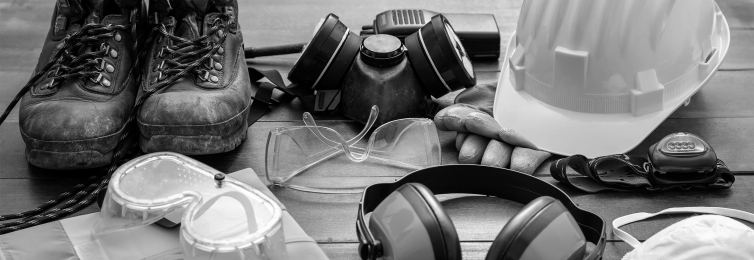In the not-too-distant future, your safety coordinator will slip on a mobile mapping backpack during their daily building walkthrough. They will be able to scan and transmit 3D models of in-progress construction back to the design team and facility operators. They’ll also use the backpack to detect potential safety hazards: guardrails that aren’t set up properly, workers who aren’t wearing personal protective equipment (PPE), or unsafe sound levels.
This scenario may not be possible yet, because the 3D modeling backpack exists, but not the ability to spot safety hazards. However, new technologies are elevating safety and productivity on the job-site, especially around PPE.
Josh Hollingsworth, Risk Management Consultant at Builders Mutual, discusses some of these PPE innovations below and outlines what contractors need to consider before adopting them for their own workers.
Better protection from head to toe
From “smart” hard hats and safety glasses to cutting-edge fall-protection devices, today’s PPE can make a real difference in keeping workers safe in all types of conditions. Here are some highlights:
- Next-generation hard hats. Some of the most advanced hard hats feature wearable technology, monitoring brain waves to detect a worker’s fatigue and alertness levels. But even simpler hard hat innovations are providing new levels of protection and comfort. Redesigned domes offer more protection from all sides, breathable foam keeps heads dry, chin straps keep the hat more secure on the head, and rails and slots around the brim can integrate accessories such as headlamps, face shields, earmuffs, and pen holders.
- Roof-mounted safety railing system. These guardrails, which fit under the eaves using metal or wood trusses, provide passive fall protection for roofers. Workers don’t need to wear safety harnesses, so they can move more freely without worrying about falling from heights. What’s more, the system can be easily removed once the roof is finished for use on another job-site.
- Suspension trauma safety straps. If a worker falls from height and is suspended in the air for a period of time, their safety harness can put pressure on their arteries and veins around the top of the legs, preventing blood flow. This can result in unconsciousness, serious injury, or even death if rescue is delayed. Harnesses are now available that use suspension trauma safety straps that allow suspended workers to quickly stand up in the harness, relieving pressure and allowing proper blood flow.
- Safety goggles. Innovations in lenses can improve both workers’ sight—and insight. Advanced coatings can prevent goggles from fogging up, so workers don’t have to remove them to wipe them clean. In addition, some tech-heavy eyewear even employs augmented reality (AR) to add a virtual, visual layer of information about unsafe temperatures, equipment status, or other potential safety hazards.
- Hearing protection. On loud construction sites, workers still need to communicate. Technology-enhanced headphones offer hear-through protection to minimize harmful noises while allowing workers the ability to hear and talk to their crew. Some new equipment can even automatically monitor external sound levels and adjust in-ear volumes accordingly.
How to make smart upgrade decisions
PPE innovations promise better safety, but adopting them for your workforce isn’t as simple as upgrading your smartphone. Here are some factors to consider before making the investment.
Understand the complete cost
Anytime contractors make a substantial change on the job-site, even to protect worker safety, the bottom line has to be evaluated. Will this change increase productivity, or save money? There’s no doubt that new PPE can be a sizable direct cost. But contractors must also study the indirect costs. Will more-innovative PPE lead to fewer injuries, fewer worker’s compensation claims, or fewer OSHA visits that could shut down the job-site for an extended period of time? Performing this type of cost-benefit analysis can help guide how to budget for PPE upgrades.
Know what’s out there
Adopting new technology can take time, in Hollingsworth’s experience. It’s not so much reluctance among contractors to change, but simply a lack of awareness about what innovations have arrived and which ones are coming down the pike. He suggests reading Safety+Health magazine from the National Safety Council (NSC), which often features innovative PPE products coming to the market. Local home builders associations also hold frequent trade shows and conferences where vendors will demo their new products, so contractors can see the safety benefits first-hand.
Think beyond PPE
Although critical to protecting workers, PPE can be the “last line of defense.” According to the Hierarchy of Controls from the National Institute for Occupational Safety and Health, innovating at the level of “engineering controls” (isolating people from hazards) or “administrative controls” (changing the way people work) may have more of an impact on safety. For example, using a table saw that’s been engineered with a water attachment to lessen the amount of airborne dust may be a wiser choice than selecting a new respirator. Or, when it comes to administrative controls, investing in training or ensuring adequate rest breaks can contribute just as much as a new piece of equipment.
Be open to change
Contractors are very receptive to all sorts of new trends—from new building designs to new tools. It’s also important to be open to new safety innovations. It may be comfortable relying on the status quo that’s worked for years. But today’s PPE enhancements can move the needle on safety. “Innovations of all kinds are designed to make our lives easier,” Hollingsworth said. “PPE innovations can make safety easier for everyone.”
If you need advice on upgrading your crews’ PPE, the risk management experts from Builders Mutual can help you select effective equipment that’s well-suited to your working conditions and business.
Contact your risk management consultant today about innovating your approach to safety.




 Find an
Find an